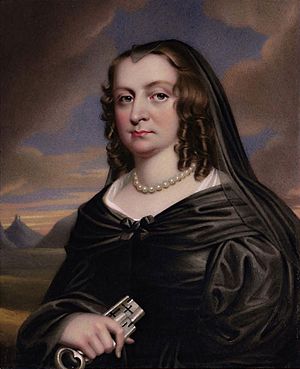Mary Bankes facts for kids
Quick facts for kids
Mary Bankes
|
|
|---|---|
 |
|
| Born |
Mary Hawtry
8 Aug 1603 |
| Died | 11 April 1661 |
| Known for | Her defence of Corfe Castle against a three-year Parliamentarian siege during the English Civil War |
| Spouse(s) | Sir John Bankes |
| Children | Sir Ralph Bankes Jerome Bankes Charles Bankes William Bankes Alice Bankes Jane Bankes Mary Bankes Joanna Bankes Elizabeth Bankes Arabella Bankes Dorothy Bankes |
Mary, Lady Bankes (née Hawtry; born around 1598 – died 11 April 1661) was a very brave English woman. She is famous for defending Corfe Castle during the English Civil War. She was a strong supporter of King Charles I. Her husband, Sir John Bankes, was an important lawyer for the King.
Contents
Early Life and Family
Mary Hawtry was born around 1598 in Ruislip, Middlesex, England. She was the only daughter of Ralph Hawtry and Mary Altham. Around 1618, she married Sir John Bankes. Sir John became a top lawyer for King Charles I. He was known as the Lord Chief Justice of the Common Pleas.
In 1635, Sir John bought Corfe Castle in Dorset. This included the castle, its lands, and all its rights. Mary and John had a large family together. They had four sons and seven daughters. Sir John died on 28 December 1644.
Mary Bankes' Children
- Sir Ralph Bankes (1631–1677)
- Jerome Bankes
- Charles Bankes
- William Bankes
- Alice Bankes, who married Sir John Borlase, 1st Baronet
- Jane Bankes, who married George Cullen
- Mary Bankes, who married Sir Robert Jenkinson
- Joanna Bankes, who married William Borlase
- Elizabeth Bankes
- Arabella Bankes, who married Samuel Gilly
- Dorothy Bankes, who married Nicholas Makareth
The Siege of Corfe Castle

In 1642, the English Civil War began. This was a fight between King Charles I and the Parliament. Sir John Bankes was called away by the King to serve in London and Oxford. Lady Mary Bankes stayed at Corfe Castle with her children and servants.
Corfe Castle was the last place loyal to the King on the Dorsetshire coast. In May 1643, a group of Parliamentarian soldiers, called Roundheads, came to the castle. They demanded that Mary give up the castle's cannons. Mary, her maidservants, and a small group of five soldiers fought back. They fired the cannons and drove the attackers away. Later, she gave up the cannons to gain time to get more supplies for the castle.
Defending the Castle
On 28 June 1643, about 500 to 600 Parliamentarian troops began a major attack on Corfe Castle. Lady Mary and her small group bravely defended the castle's Upper Ward. They threw stones and hot embers down from the castle walls. This helped them to push back the attackers. In August, they managed to kill or wound over 100 enemy soldiers.
The siege continued for a long time. In 1646, one of Mary's officers, Colonel Pitman, betrayed her. He let Parliamentarian soldiers into the castle through a secret gate. These soldiers had turned their jackets inside out to look like Royalists. Because of this trick, Lady Bankes was forced to surrender the castle.
After the Surrender
Even though she had to give up, Lady Bankes showed such great courage. The Parliamentarian commander allowed her to keep the keys of the castle. These historic keys are now kept at Kingston Lacy, a famous house near Wimborne Minster, Dorset. After the castle was captured, the Parliament ordered it to be destroyed. This was done to make sure it could not be used again in the war.
It is known that Mary's sons, Ralph and Jerome, bought a piece of land called Eastcourt for her. After her death, this land went to her daughter Joanna Borlase.
Later Life and Legacy
Lady Mary Bankes died on 11 April 1661. She was buried in St Martin's Church, Ruislip. There is a special monument inside the church that remembers her. It talks about her bravery and strength during the difficult times of the Civil War.
Today, a school in Ruislip Manor is named after her. It is called Lady Bankes Primary School.

